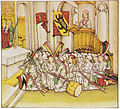Laupenkrieg
| date | June 21, 1339 |
|---|---|
| place | Laupen in the canton of Bern , Switzerland |
| output | Victory of the Bernese |
| Parties to the conflict | |
|---|---|
|
Troops in the west : Troops in the east : Dukes of Austria, Grafschaft Neu-Kyburg,
knights from Swabia and Alsace |
Burgundian Confederation |
| Commander | |
|
Gerhard of Valangin |
|
| Troop strength | |
| 12,000 | 6,000? |
The Laupen war , the 1339 in Laupen raged was a conflict between city and Republic of Berne one hand, and a broad coalition of western Switzerland nobility and the Habsburg city of Freiburg on the other hand, from the city of Bern emerged victorious.
prehistory
When the house of the Zähringers died out in 1218 , the city of Bern became free of the empire . In the following years, the Bernese succeeded in considerably expanding their area on both sides of the Aare . This striving for expansion displeased the Burgundian nobility and the city of Freiburg , at whose expense the Bernese grew. Also wanted Bern Ludwig of Bavaria not recognize as Holy Roman Emperor, as the Pope against him the excommunication had said. Ludwig commissioned Gerhard von Valangin to take action against the city of Bern, whereupon he opened the feud . Attempts to mediate in Neuenegg in 1338 failed. The conflict was triggered by an attack by the Count of Valangin on Bern in 1339 and the subsequent counterattack by Bern on the city of Aarberg , to which the Count had withdrawn. Bern subsequently occupied the castle and town of Laupen and established itself there.
The conflict
The battle was preceded by an eleven day siege of the castle and the city of Laupen by an army of 12,000 loyal to the emperor under Gerhard von Valangin and the Bishop of Basel , Johann II. Senn von Münsingen . The 600 man strong crew of the castle defied under the command of the knight Johann III. von Bubenberg , son of the Bernese mayor, and Burkhard von Bennenwil , small councilor of Bern, the aristocratic army, until June 21, 1339 an allegedly 6000-strong allied army arrived, consisting of the Bernese and their comrades from the Swiss forest sites , with whom they since 1323 were in a limited alliance, as well as the Solothurn , Simmental , Weissenburg and Oberhasler .
According to the chronicler Konrad Justinger , the leader of the confederates was the Bernese knight Rudolf von Erlach . The Spiez Chronicle by Diebold Schilling the Elder shows the encounter between the central Swiss troops and the Bernese who had already been assembled. The Bernese pastor Diebold Baselwind rides the army ahead with a monstrance . Since Ludwig was exempt from church, the Bernese understood the campaign as an action against the enemies of the Roman church .
At the same time an army of the Dukes of Austria and the Counts of Neu-Kyburg gathered in Aargau east of Bern . This was probably the reason why the Bernese mayor Johann II von Bubenberg stayed in the city and transferred the leadership of the move to Laupen to Rudolf von Erlach , in order to take over the defense of the city of Bern himself in the event of an attack from the east.
Shortly before Laupen, on the Bramberg, the Bernese and their allies encountered troops from Burgundy and the city of Friborg , the armies of the bishops of Basel and Lausanne and the allegiance of the Counts of Gruyères , the lords of Vaud , and the Counts of Nidau , from Neuchâtel , from Savoy , and from Aarberg . The battle broke out, which ended victorious for Bern. The surviving opponents fled and the crew of Laupen could be freed. The Habsburg-Kyburg troops in the east could not advance in time and disbanded after receiving the message of the defeat.
Proverbs like: "God himself became a citizen in Bern" allegedly made the rounds of the retreating opponents of the city of Bern after the battle was lost.
The consequences
Although the battle ended victorious for Bern, the conflict did not end. In a guerrilla war, the nobility and Freiburg tried to further weaken Bern with raids and an economic blockade. It was not until 1340 that Agnes of Hungary brokered a peace between the parties.
The city of Bern entered the old Swiss Confederation in 1353 as the eighth place and vowed eternal friendship. However , Bern did not take part in the Battle of Sempach in 1386. In the old Zurich War of 1444–1446, however, the Bernese moved to Greifensee 150 kilometers away to support the Swiss Confederation . In the Burgundy Wars , Bern received federal support again.
Web links
- Christian Folini: Laupenkrieg. In: Historical Lexicon of Switzerland .
- Middle High German report on the battle in the Chronicle by Conrad Justinger Quoted in G. Studer, the Berner Chronik by Conrad Justinger, 1871 pp. 72–94 [1]
literature
- Rudolf Emanuel Stierlin: The Times of the Laupen War, 1340 . Bern 1822.
- Richard Feller, Bern 1974, The history of Bern from its beginnings to 1516




